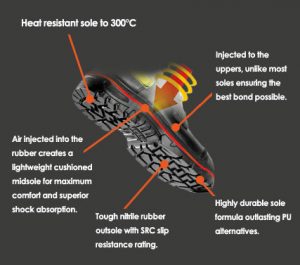Technology
 Technology: Dual Density Rubber injected soling system (DDR)
Technology: Dual Density Rubber injected soling system (DDR)
Choosing a Dual Density Injected Sole construction means you have a special application, for a job role that demands long lasting high abrasion resistance performance, flexibility and comfort. The injection method that squeezes the rubber material at high pressure into the sole mould at two different densities produces a permanent high strength bond between the upper and sole as the two parts are combined.
This sole construction is suitable for fire fighting, public order, metal processing, and other specialist industrial applications that share the theme of danger or extreme environments day to day.
Specialised Rubber Compounds
Goliath produces many different rubber compounds mixed with chemicals to produce the best performance for the application. The material has a heat resistance of 300°C and benefits from having a long shelf life. There are different formulas for improved slip resistance, weight, flexibility and use at different global temperatures. The rubber is formed into long strands and injected into the sole mould using the latest DESMA technology robots.
Long Shelf Life
Products with DDR sole systems have a 10 year+ shelf life, which is particularly important for countries with high humidity. DDR significantly out-performs PU soled footwear, which can degrade over a short time, so you can be assured that DDR soles will maintain the highest quality in storage.
Midsole
The midsole is a lower density rubber compound that has been injected with air bubbles. This material provides flexibility and shock absorption not found in direct vulcanized rubber soles. These properties increase ground contact for better slip resistance, stability and also provides cold and heat insulation improving the overall performance of the footwear for high risk applications.
Outsole
The outer part of the sole unit is high density compact rubber material with high abrasion resistance, protecting from nicks and cuts and durable properties lasting longer than PU alternatives. It passes the European standards most advanced slip resistance test and is rated SRC. With a heat resistance of 300 degrees throughout the sole, it is suitable for heavy industrial environments.
 Summary:
Summary:
• Protected in-house rubber formula (added flame resistance properties).
• Two distinct rubber density layers.
• Air injected midsole.
• Injected to uppers for optimum bond.
• Heat resistant to 300°C
• Long shelf life
• SRC rated slip resistance.
 Technology: GORE-TEX fabrics
Technology: GORE-TEX fabrics
Dry & Comfortable
GORE-TEX® Performance Comfort Footwear is designed for a wide range of outdoor activities. All the materials used, from the sole to the shaft, are selected with the greatest of care and combined in a perfectly-fitting shoe. Performance Comfort Footwear is not only durably waterproof and breathable, it is also robust and hardwearing, giving you maximum protection and comfort no matter how long and demanding the work.
GORE-TEX® Footwear has to withstand up to 300,000 flexes (300 km/80 h) in ankle high water – no water entry allowed into the footwear from the outside.This is much stricter than EN ISO 20345/347, which requires:
1. 1,000 Flexes / 15 Minutes (Trough Test) and
2. 4,800 Flexes / 80 Minutes (DynamicTest) while 3cm2 water entry is allowed.
GORE-TEX® Footwear has to withstand 240 turns/min in the centrifuge without showing any leakage.
Boots are filled with water and then spun at high speed. The huge centrifugal pressure will force the water out of the shoe or boot if there is any weakness or faults in the waterproof construction. Continual production: 2% of the daily production or three pairs of shoes per hour must be tested for 30 minutes. Prototype testing is for 60 minutes.
GORE-TEX® Footwear has to achieve a certain climate comfort value depending on the specific product class.
The Whole Boot Comfort Test measures the breathability of the whole boot. The effect of a ‘sweating’ artificial foot in the boot is simulated in a temperature controlled microclimate. The final climate comfort value of the tested GORE-TEX® footwear is determined based on the degree of water vapour diffusion and water vapour absorption of the boot.
 Technology: CROSSTECH
Technology: CROSSTECH
Meeting the Demands of Rescue and Recovery
If the risk assessment of the operating environment addresses the need for durable protection against blood and body fluids, CROSSTECH® Laminates provide the solution. CROSSTECH® Laminates are the most durable blood and body fluid penetration resistant and breathable moisture barrier.
• Superior liquid penetration resistance
• Easy to care for
• Prevents perspiration build-up
• Breathable comfort
Protective leather boots made with CROSSTECH® fabric give firefighters safer mobility and better agility than heavy rubber boots. CROSSTECH® footwear fabric offers superior liquid penetration and thermal protection, while reducing moisture condensation for drier, more comfortable feet.
 Technology: D3O®
Technology: D3O®
The Goliath Force boot and Control Public order boot integrate a revolutionary metatarsal protector using material called D3O®. D3O® is engineered using intelligent molecules that flow with you whilst you work providing a flexible and comfortable metatarsal guard. If energy is applied in the form of a falling object impacting with the metatarsal guard, then the molecules lock together to absorb the impact energy. This makes the footwear far more comfortable to wear than conventional metatarsal guards and also means you can bend down in the footwear without the guard cutting into your foot.
